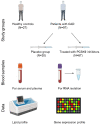Gene Expression Profiling of Markers of Inflammation, Angiogenesis, Coagulation and Fibrinolysis in Patients with Coronary Artery Disease with Very High Lipoprotein(a) Levels Treated with PCSK9 Inhibitors
- PMID: 35877573
- PMCID: PMC9324258
- DOI: 10.3390/jcdd9070211
Gene Expression Profiling of Markers of Inflammation, Angiogenesis, Coagulation and Fibrinolysis in Patients with Coronary Artery Disease with Very High Lipoprotein(a) Levels Treated with PCSK9 Inhibitors
Abstract
Besides lipids, inflammation, angiogenesis, coagulation and fibrinolysis play very important roles in coronary artery disease (CAD). We measured gene expression of the inflammatory markers interleukin (IL)-1β (IL1B) and interferon (IFN)-γ (IFNG), vascular endothelial growth factor-A (VEGF-A) (VEGFA), and coagulation and fibrinolysis markers tissue factor (TF) (F3) and plasminogen activator inhibitor-1 (PAI-1) (SERPINE) in healthy controls and CAD patients with high lipoprotein(a) (Lp(a)). The aim of our study was to identify, first, if there is a difference in these markers between controls and patients; secondly, if these markers are associated with lipids; and third, what the influence of proprotein convertase subtilisin/kexin type 9 (PCSK9) inhibitors is on these markers. We included 124 subjects, 27 controls and 97 patients with CAD (30 in placebo and 67 in the PCSK9 group). Blood samples were collected for lipid and gene measurement. The results showed higher expression of IL1B (p < 0.0001), VEGFA (p < 0.0001), and F3 (p = 0.018) in controls in comparison with patients. Significant correlations were observed between IL1B and lipids. Treatment with PCSK9 inhibitors increased VEGFA (p < 0.0001) and F3 (p = 0.001), and decreased SERPINE (p = 0.043). The results of our study underpin the importance of IL-1β, VEGF-A and TF in CAD as well as the effect of PCSK9 treatment on these markers.
Keywords: PCSK9 inhibitors; coagulation; coronary artery disease; fibrinolysis; inflammation; interleukin-1; lipoprotein(a); plasminogen activator inhibitor-1; tissue factor; vascular endothelial factor-A.
Conflict of interest statement
The authors declare that they have no conflict of interest.
Figures





Similar articles
-
Predictors of functional and morphological arterial wall properties in coronary artery disease patients with increased lipoprotein (a) levels before and after treatment with proprotein convertase subtilisin-kexin type 9 inhibitors.Cardiovasc Ultrasound. 2023 Aug 14;21(1):15. doi: 10.1186/s12947-023-00313-9. Cardiovasc Ultrasound. 2023. PMID: 37580777 Free PMC article.
-
Proprotein convertase subtilisin-kexin type 9 as a biomarker for the severity of coronary artery disease.Ann Med. 2015;47(5):386-93. doi: 10.3109/07853890.2015.1042908. Epub 2015 Jul 10. Ann Med. 2015. PMID: 26153823
-
Increased sortilin and its independent effect on circulating proprotein convertase subtilisin/kexin type 9 (PCSK9) in statin-naive patients with coronary artery disease.Int J Cardiol. 2017 Jan 15;227:61-65. doi: 10.1016/j.ijcard.2016.11.064. Epub 2016 Nov 8. Int J Cardiol. 2017. PMID: 27846466
-
Role of proprotein convertase subtilisin/kexin type 9 inhibitors in patients with coronary artery disease undergoing percutaneous coronary intervention.Expert Rev Cardiovasc Ther. 2018 Jun;16(6):419-429. doi: 10.1080/14779072.2018.1474099. Epub 2018 May 23. Expert Rev Cardiovasc Ther. 2018. PMID: 29737886 Review.
-
Sex difference in circulating PCSK9 and its clinical implications.Front Pharmacol. 2022 Sep 7;13:953845. doi: 10.3389/fphar.2022.953845. eCollection 2022. Front Pharmacol. 2022. PMID: 36160427 Free PMC article. Review.
Cited by
-
Lipoprotein(a) as a Risk Factor for Cardiovascular Diseases: Pathophysiology and Treatment Perspectives.Int J Environ Res Public Health. 2023 Sep 6;20(18):6721. doi: 10.3390/ijerph20186721. Int J Environ Res Public Health. 2023. PMID: 37754581 Free PMC article. Review.
-
Competing Endogenous RNA Regulatory Networks of hsa_circ_0126672 in Pathophysiology of Coronary Heart Disease.Genes (Basel). 2023 Feb 22;14(3):550. doi: 10.3390/genes14030550. Genes (Basel). 2023. PMID: 36980823 Free PMC article.
-
The evolving landscape of PCSK9 inhibition in cancer.Eur J Pharmacol. 2023 Jun 15;949:175721. doi: 10.1016/j.ejphar.2023.175721. Epub 2023 Apr 12. Eur J Pharmacol. 2023. PMID: 37059376 Free PMC article. Review.
-
Rationale for Early Administration of PCSK9 Inhibitors in Acute Coronary Syndrome.Rev Cardiovasc Med. 2024 Oct 22;25(10):374. doi: 10.31083/j.rcm2510374. eCollection 2024 Oct. Rev Cardiovasc Med. 2024. PMID: 39484117 Free PMC article. Review.
-
Effect of PCSK9 Inhibitors on Regulators of Lipoprotein Homeostasis, Inflammation and Coagulation.Biomedicines. 2025 Jan 24;13(2):294. doi: 10.3390/biomedicines13020294. Biomedicines. 2025. PMID: 40002707 Free PMC article.
References
-
- Mach F., Baigent C., Catapano A.L., Koskina K.C., Casula M., Badimon L., Chapman M.J., De Backer G.G., Delgado V., Ference B.A., et al. 2019 ESC/EAS guidelines for the management of dyslipidaemias: Lipid modification to reduce cardiovascular risk. Atherosclerosis. 2019;290:140–205. doi: 10.1016/j.atherosclerosis.2019.08.014. - DOI - PubMed
Grants and funding
LinkOut - more resources
Full Text Sources
Miscellaneous

